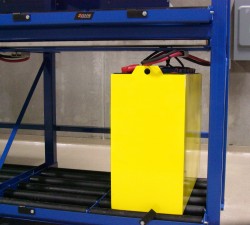We use cookies to make your experience better. To comply with the new e-Privacy directive, we need to ask for your consent to set the cookies. Learn more.
How Lead-Acid Forklift Batteries Work
Electric lift trucks made up 64 percent of the U.S. forklift market last year; by now, it’s likely that some (or all) of your fleet runs on lead-acid battery power.
When you’re used to seeing electric forklifts zip around a facility every day, it’s easy to take their power source for granted. However, the lead-acid forklift battery is worth considering in some detail. It’s a fascinating technology, and understanding the basic science behind forklift batteries will help you implement effective battery maintenance programs and improve the efficiency of your entire fleet.

Three substances interact within the cell of a lead-acid forklift battery:
- Plates of lead dioxide.
- Plates of pure, soft lead called “spongy lead.”
- An electrolyte mixture of sulfuric acid and water.
Each battery cell contains layers of lead dioxide and spongy lead in alternating plates. When the acidic electrolyte comes into contact with these compounds, complex chemical reactions create an imbalance of electrons between the two types of plates. Electrons will naturally flow from the negative plate toward the positive plate, attempting to correct the imbalance of subatomic particles.
The lead dioxide plates all connect to a single positive terminal while the plates of spongy lead attach to a negative terminal; these terminals create an external circuit. If we connect the terminals to a conductor — say, a forklift’s power system — electrons will move from terminal to terminal through the conductor. That’s how we harness the voltage generated by the battery’s chemical reactions.
Forklift battery chargers reverse the process with a steady flow of voltage. The energy from the charger converts lead sulfate back into its original forms of lead, increasing the specific gravity of the sulfuric acid present in the electrolyte. This prepares the battery to restart the discharge process. It’s less like filling a gas tank and more like evaporating and condensing the same glass of water again and again.
Chemical Reactions and Forklift Battery Maintenance
Like any chemical reaction, the interplay between sulfuric acid, water, and lead produces new substances. When left unchecked, these substances can limit the efficiency of batteries, or even damage the battery cells themselves.
Forklift batteries generate lead sulfate and water as they discharge. The growth of lead sulfate is called sulfation, and it can reduce the effectiveness of batteries. Regular washes in a dedicated battery wash cabinet can help remove the chalky lead sulfate that builds up on terminals. Washing also removes leaked electrolyte, preventing unwanted discharge.
Discharging forklift batteries also transforms a lot of the electrolyte into water, which splits into hydrogen and oxygen molecules. As these molecules escape, the water level in the battery cell will drop. This creates a danger to the plates; if plates are exposed to the air, they will oxidize, permanently losing capacity.
Under certain conditions, batteries also give off hydrogen and oxygen gasses during the charging process. This is called “gassing,” and it’s the reason that lead-acid battery ventilation requirements are so strict in battery changing areas. Gassing also leads to water loss. Keep a strict schedule for monitoring battery cells, replacing water whenever necessary. Consider installing an integrated watering system to automatically water entire battery collections when the charging process is complete.
Don’t worry if maintenance tasks start to seem overwhelming. A battery fleet management system like BHS Fleet Tracker can help keep you to your schedule. It’s also helpful to train your staff on the details of how electric forklift batteries actually work — it’s always easier to follow maintenance schedules when you know exactly what’s going on inside the battery case.
References:
“BU-403: Charging Lead Acid” Battery University. Cadex Electronics Inc., n.d. Web. 15 July 2015.
Faust, Brian. "Electric forklifts gain acceptance, driven by sustainability features: electric forklifts cut emissions, use less energy, and minimize waste and maintenance." Food Logistics 2014: 40. General OneFile. Web. 15 July 2015.
"Lead-Acid Battery." HyperPhysics. Georgia State University Department of Physics and Astronomy, n.d. Web. 15 July 2015.
"Lead Acid Batteries." Battery Council International. Battery Council International, 2012. Web. 15 July 2015.
